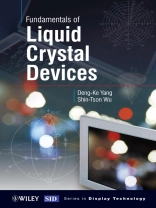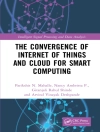From laptop computers and mobile phones to digital cinema, Liquid
Crystal Displays (LCDs) are integral components in an increasing
array of highly desirable consumer electronics and communication
devices, and are already the predominant technology used in flat
panel displays.
This inter-disciplinary book is intended as an introductory
guide to the fundamental properties of liquid crystals and their
applications in display and photonic devices, providing a basic
understanding of the physics, optics, electro-optics, and material
aspects for state-of-the-art display and photonic devices.
Fundamentals of Liquid Crystal Devices
includes:
* A comprehensive overview of LCDs including liquid crystal
physics, electro-optical properties, simulation techniques and
display and photonic applications.
* Numerous examples and case studies, solved problems and
challenging homework conundrums starting with basic physics and
gradually introducing advanced device concepts and structures.
* The principles for designing advanced specialist transmissive,
reflective, and transflective liquid crystal displays.
* Chapters on emerging technologies such as tuneable liquid
crystal photonic devices including laser beam steering, light
switches for telecommunication and tunable-focus lenses.
Fundamentals of Liquid Crystal Devices is a
valuable resource for advanced undergraduate and graduate students
following display systems courses, who will benefit from its
systematic approach. The introduction of advanced device concepts
and structures means that display engineers, scientists, and
technicians active in the field can also utilise this unique
resource, as can developers of a wide range of systems and
applications.
The Society for Information Display (SID) is an international
society, which has the aim of encouraging the development of all
aspects of the field of information display. Complementary to the
aims of the society, the Wiley-SID series is intended to explain
the latest developments in information display technology at a
professional level. The broad scope of the series addresses all
facets of information displays from technical aspects through
systems and prototypes to standards and ergonomics
İçerik tablosu
Foreword.
Series Editor’s Foreword.
Preface.
1. Liquid crystal physics.
* Introduction.
* Thermodynamics and statistic physics.
* Orientational order.
* Elastic properties of liquid crystals.
* Response of liquid crystals to electro-magnetic fields.
* Anchoring effects of nematic liquid crystal at surfaces.
2. Propagation of light in anisotropic optical
medium.
* Electromagnetic wave.
* Polarization.
* Propagation of light in uniform anisotropic optical media.
* Propagation of light in cholesteric liquid crystals.
3. Optical modeling methods.
* Jones matrix method.
* Mueller matrix method.
* Berreman 4×4 method.
4. Effects of Electric field on Liquid Crystals.
* Dielectric interaction.
* Flexoelectric Effect.
* Ferroelectricity in liquid crystals.
5. Freedericksz transition.
* Calculus of variation.
* The Fredeericksz transition: statics.
* The Freedericksz transition: dynamics.
6. Liquid Crystal Materials.
* Introduction.
* Refractive indices.
* Dielectric constants.
* Rotational Viscosity.
* Elastic constant.
* Figure-of-merits.
* Refractive index matching between liquid crystals and
polymers.
7. Modeling of liquid crystal director configuration.
* Electric energy of liquid crystals.
* Modeling electric field.
* Simulation of liquid crystal director configuration.
8. Transmissive liquid crystal display.
* Introduction.
* Twisted nematic cells.
* In plane switching (IPS) mode.
* Vertical alignment (VA) mode.
* Multi-domain Vertical Alignment (MVA) Cells.
* Optically compensated bend (OCB) cell.
9. Reflective and Trasreflective display.
* Introduction.
* Reflective liquid crystal displays.
* Transflector.
* Classification of id=’OLE_LINK17′ name=’OLE_LINK17’>Transflective LCDs.
* Dual-cell-gap Transflective LCDs.
* Single-cell-gap Transflective LCDs.
* Performance of transflective LCDs.
10. Liquid crystal display matrices, drive schemes and
bistable displays.
* Segmented displays.
* Passive matrix displays and drive scheme.
* Active Matrix Displays.
* Bistable ferroelectric liquid crystal displays and drive
scheme.
* Bistable nematic displays.
* Bistable cholesteric reflective display.
11. Liquid crystal/polymer composites.
* Introduction.
* Phase separation.
* Scattering properties of liquid crystal/polymer
composites.
* Polymer dispersed liquid crystals.
* Polymer stabilization liquid crystals.
* Displays from liquid crystal/polymer composites.
12. Tunable liquid crystal photonic devices.
* Introduction.
* Laser beam steering.
* Variable Optical Attenuators.
* Tunable-Focus Lens.
* Polarization-Independent LC Devices.
Index.
Yazar hakkında
Deng-Ke Yang, Liquid Crystal Institute, Kent State
University, Kent, OH 44242Deng-Ke Yang is currently Professor of
the Chemical Physics Program at Kent State University. He has
previously co-authored Reflective Liquid Crystal Displays (Wiley,
2001), written over 80 articles on liquid crystals and other
displays and has 15 patents. His fields of research are in Liquid
Crystal and Polymer Physics and Liquid Crystal Displays and his
affiliations include the American Physical Society, the Society for
Information Display and the International Liquid Crystal Society.
Dr Shin-Tson Wu, College of Optics and Photonics,
University of Central Florida. Shin-Tson Wu is a
provost-distinguished Professor of Optics at the College of Optics
and Photonics, University of Central Florida. He is also a fellow
of the IEEE, SID and OSA and has co-authored Introduction to
Microdisplays (Wiley, 2006), Reflective Liquid Crystal Displays
(Wiley, 2001), and Optics and Nonlinear Optics of Liquid Crystals
(World Scientific, 1993), and written over 300 articles. His
research interests are in liquid crystal displays and materials,
bio-photonics, and optical communication.. Previous to his current
role, Dr. Wu worked as a Senior Research Scientist at Hughes
Research Laboratories (Malibu, California) for 18 years.












